1994 CHEVROLET CAVALIER rear view mirror
[x] Cancel search: rear view mirrorPage 73 of 243
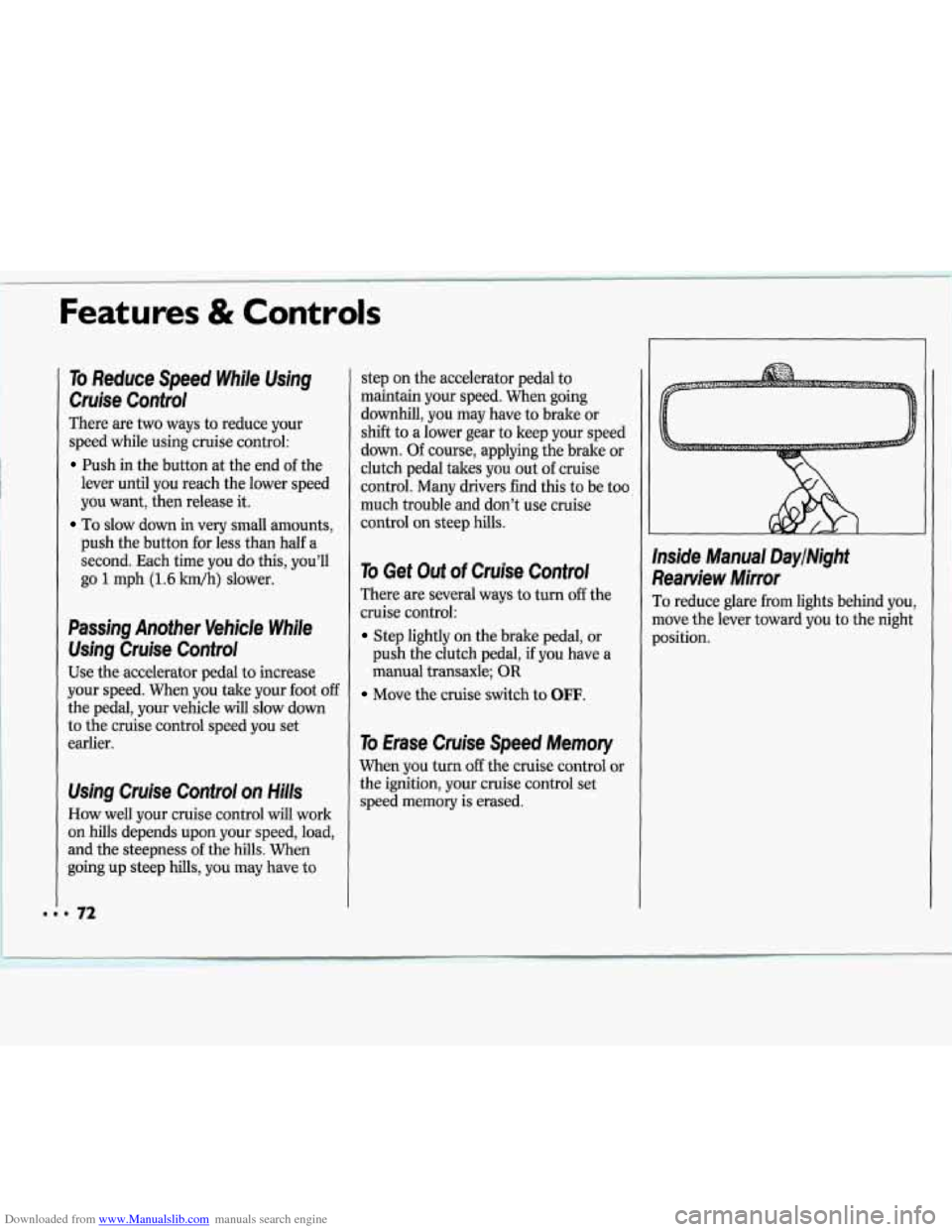
Downloaded from www.Manualslib.com manuals search engine Features & Controls
To Reduce Speed While Using
Cruise Control
There are two ways to reduce your
speed while using cruise control:
Push in the button at the end of the
lever until you reach the lower speed
you want, then release
it.
To slow down in very small amounts,
push the button for less than half a
second. Each time you do this, you’ll
go
1 mph (1.6 km/h) slower.
Passing Another Vehicle While Using Cruise Control
Use the accelerator pedal to increase
your speed. When you take your foot
off
the pedal, your vehicle will slow down
to the cruise control speed you set
earlier.
Using Cruise Control on Hills
How well your cruise control will work
on hills depends upon your speed, load,
and the steepness of the hills. When
going
up steep hills, you may have to step
on the accelerator pedal to
maintain your speed. When going
downhill, you may have to brake or
shift to a lower gear to keep your speed
down. Of course, applying the brake or
clutch pedal takes you out of cruise
control. Many drivers find this to be too,
much trouble and don’t use cruise
control on steep hills.
To Get Out of Cruise Control
There are several ways to turn off the
cruise control:
Step lightly on the brake pedal, or
push the clutch pedal,
if you have a
manual transaxle; OR
Move the cruise switch to OFF.
To Erase Cruise Speed Memory
When you turn off the cruise control or
the ignition, your cruise control set
speed memory is erased.
Inside Manual DaylNight
Rearview Mirror
To reduce glare from lights behind you,
move the lever toward you to the night
position.
Page 118 of 243
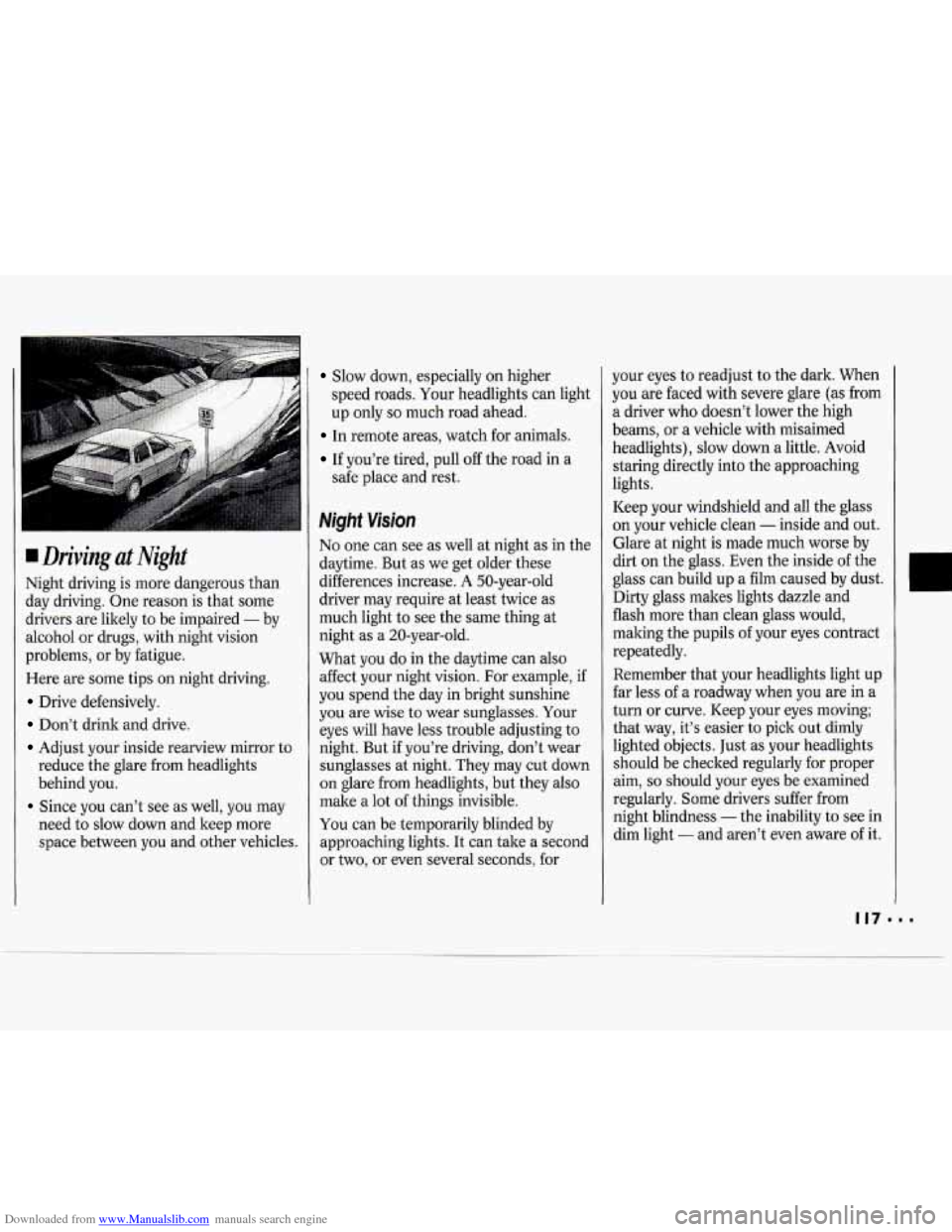
Downloaded from www.Manualslib.com manuals search engine Driving at Night
Night driving is more dangerous than
day driving. One reason is that some
drivers are likely to be impaired
- by
alcohol or drugs, with night vision
problems, or by fatigue.
Here are some tips on night driving.
Drive defensively.
Don’t drink and drive.
Adjust your inside rearview mirror to
reduce the glare from headlights
behind you.
Since you can’t see as well, you may
need to slow down and keep more
space between you and other vehicles.
Slow down, especially on higher
speed roads. Your headlights can light
up only
so much road ahead.
In remote areas, watch for animals.
If you’re tired, pull off the road in a
safe place and rest.
Night Vision
No one can see as well at night as in the
daytime. But as we get older these
differences increase.
A 50-year-old
driver may require at least twice as
much light to see the same thing at
night as a 20-year-old.
What you do in the daytime can also
affect your night vision. For example, if
you spend the day in bright sunshine
you are wise to wear sunglasses. Your
eyes will have less trouble adjusting to
night. But if you’re driving, don’t wear
sunglasses at night. They may cut down
on glare from headlights, but they also
make a lot
of things invisible.
You can be temporarily blinded by
approaching lights. It can take a second
or two, or even several seconds, for your eyes
to readjust to the dark. When
you are faced with severe glare (as from
a driver who doesn’t lower the high
beams, or a vehicle with misaimed
headlights), slow down
a little. Avoid
staring directly into the approaching
lights.
Keep your windshield and all the glass
on your vehicle clean - inside and out.
Glare at night is made much worse by
dirt on the glass. Even the inside of the
glass can build up a film caused by dust.
Dirty glass makes lights dazzle and
flash more than clean glass would,
malting the pupils of your eyes contract
repeatedly.
Remember that your headlights light up
far less of a roadway when you are in a
turn or curve. Keep your eyes moving;
that way, it’s easier to pick out dimly
lighted objects. Just as your headlights
should be checked regularly for proper
aim,
so should your eyes be examined
regularly. Some drivers suffer from
night blindness
- the inability to see in
dim light
- and aren’t even aware of it.
7
Page 122 of 243
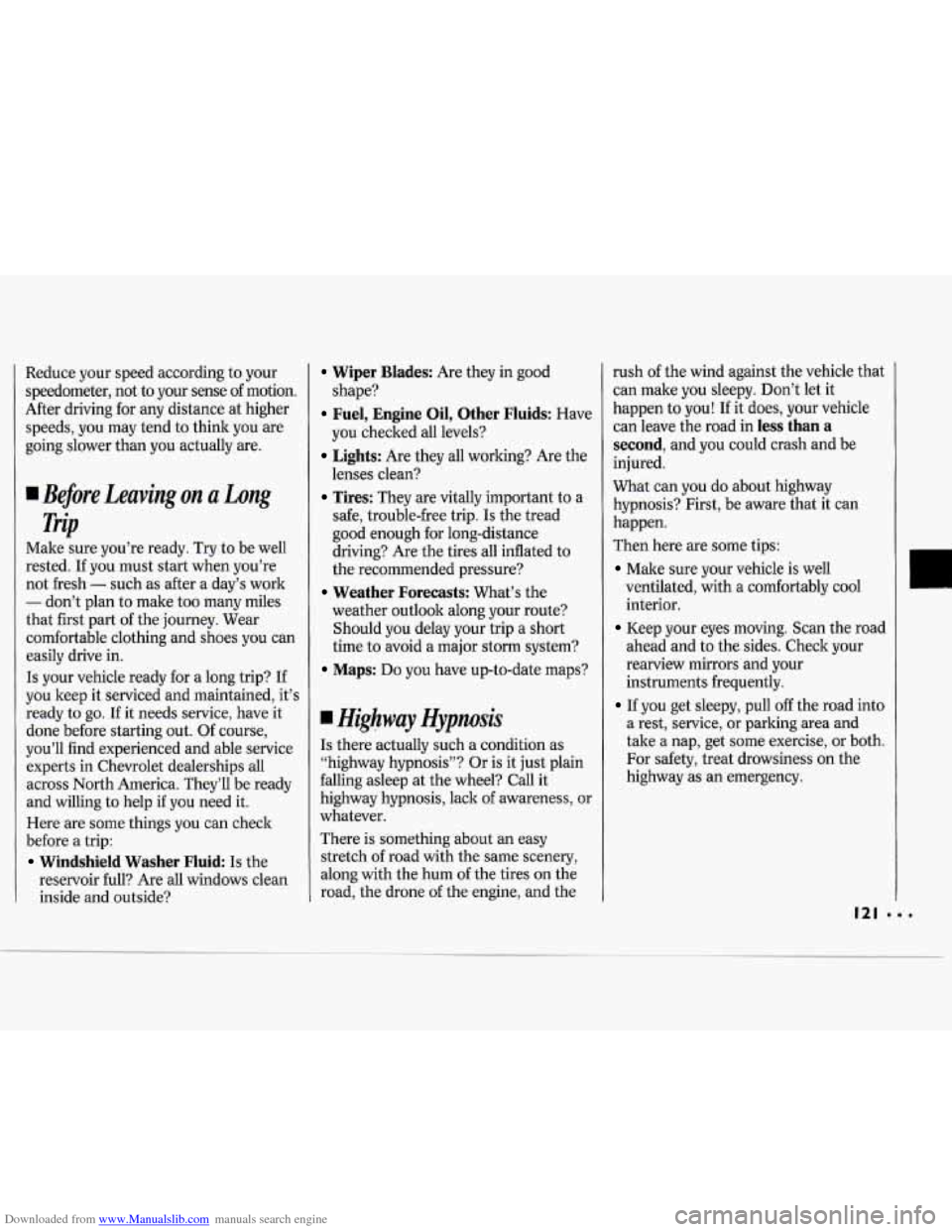
Downloaded from www.Manualslib.com manuals search engine Reduce your speed according to your
speedometer, not to your sense of motion.
After driving for any distance at higher
speeds, you may tend
to think you are
going slower than you actually are.
Before Leaving on a Long
Trip
Make sure you’re ready. Try to be well
rested.
If you must start when you’re
not fresh
- such as after a day’s work
- don’t plan to make too many miles
that first part
of the journey. Wear
comfortable clothing and shoes you can
easily drive in.
Is your vehicle ready for a long trip? If
you keep it serviced and maintained, it’s
ready to
go. If it needs service, have it
done before starting out. Of course,
you’ll find experienced and able service
experts in Chevrolet dealerships all
across North America. They’ll be ready
and willing to help
if you need it.
Here are some things you can check
before a trip:
Windshield Washer Fluid Is the
reservoir full? Are all windows clean
inside and outside?
Wiper Blades: Are they in good
shape?
Fuel, Engine Oil, Other Fluids: Have
you checked all levels?
Lights: Are they all working? Are the
lenses clean?
Tires: They are vitally important to a
safe, trouble-free trip.
Is the tread
good enough for long-distance
driving? Are the tires all inflated to
the recommended pressure?
weather outlook along your route?
Should you delay your trip a short
time to avoid a major storm system?
Maps: Do you have up-to-date maps?
Weather Forecasts: What’s the
Highway Hypnosis
Is there actually such a condition as
“highway hypnosis”? Or is it just plain
falling asleep at the wheel? Call it
highway hypnosis, lack
of awareness, or
whatever.
There is something about an easy
stretch of road with the same scenery,
along with the hum of the tires on the
road, the drone
of the engine, and the rush
of the wind against the vehicle that
can make you sleepy. Don’t let it
happen to you! If it does, your vehicle
can leave the road in
less than a
second,
and you could crash and be
injured.
What can you do about highway
hypnosis? First, be aware that it can
happen.
Then here are some tips:
Make sure your vehicle is well
ventilated, with a comfortably cool
interior.
Keep your eyes moving. Scan the road
ahead and to the. sides. Check your
rearview mirrors and your
instruments frequently.
If you get sleepy, pull off the road into
a rest, service, or parking area and
take a nap, get some exercise, or both.
For safety, treat drowsiness
on the
highway as an emergency.
a
Page 237 of 243
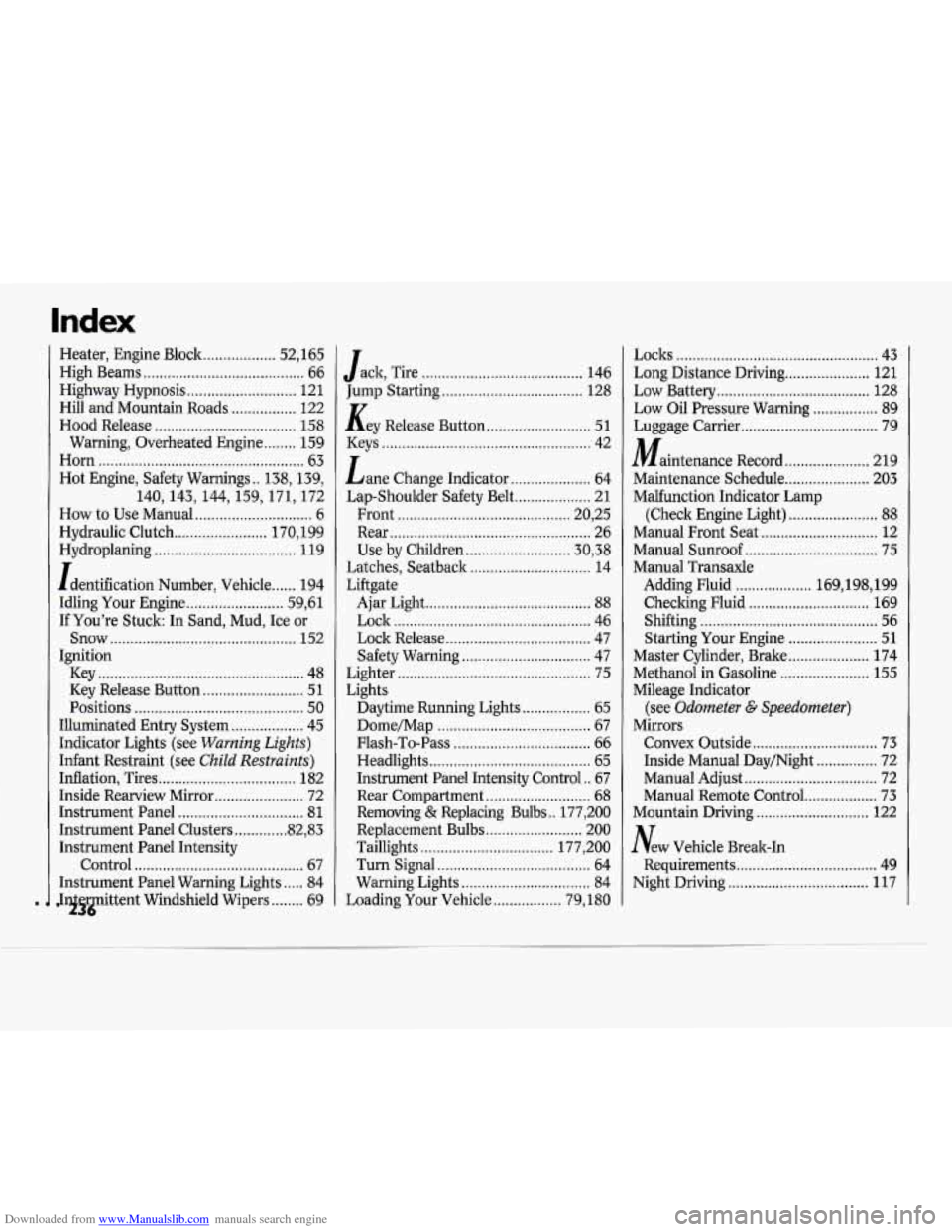
Downloaded from www.Manualslib.com manuals search engine Heater. Engine Block .................. 52. 165
High Beams ........................................ 66
Highway Hypnosis
........................... 121
Hill and Mountain Roads
................ 122
Hood Release
................................... 158
Warning. Overheated Engine
........ 159
Horn
................................................... 63
Hot Engine. Safety Warnings
.. 138. 139.
140.143.144.159.171. 172
How to Use Manual ............................. 6
Hydraulic Clutch
....................... 170. 199
Hydroplaning
................................... 1 19
Identification Number. Vehicle
...... 194
If You're Stuck: In Sand. Mud. Ice or
Ignition Idling Your Engine
........................ 59. 61
Snow .............................................. 152
Key
................................................... 48
Key Release Button
......................... 51
Positions
.......................................... 50
Illuminated Entry System
.................. 45
Indicator Lights (see
Warning Lights)
Infant Restraint (see Child Restraints)
Inflation. Tires .................................. 182
Inside Rearview Mirror
...................... 72
Instrument Panel
............................... 81
Instrument Panel Clusters ............. 82. 83
Instrument Panel Intensity
Control
.......................................... 67
Instrument Panel Warning Lights 84
ittent Windshield Wipers 69
.....
.'95iP ........
Jack. Tire ........................................ 146
Key Release Button .......................... 51
Jump Starting
................................... 128
Keys
.................................................... 42
Lap-Shoulder Safety Belt
................... 21
Use by Children
.......................... 30'38
Latches, Seatback
.............................. 14
Liftgate
Lane
Change Indicator
.................... 64
Front
........................................... 20, 25
Rear .................................................. 26
Ajar Light
......................................... 88
Lock ................................................. 46
Lock Release
.................................... 47
Safety Warning
................................ 47
Lighter
................................................ 75
Lights Daytime Running Lights
................. 65
Dome/Map ...................................... 67
Flash-To-Pass
.................................. 66
Headlights
........................................ 65
Instrument Panel Intensity Control
.. 67
Rear Compartment
.......................... 68
Removing & Replacing Bulbs .. 177, 200
Replacement Bulbs
........................ 200
Taillights
................................. 177, 200
Turn Signal
...................................... 64
Warning Lights
................................ 84
Loading Your Vehicle
................. 79, 180 Locks
.................................................. 43
Long Distance Driving
..................... 121
Low Battery
...................................... 128
Low Oil Pressure Warning
................ 89
Maintenance Record ..................... 219
Maintenance Schedule
..................... 203
Malfunction Indicator Lamp
(Check Engine Light)
...................... 88
Manual Front Seat ............................. 12
Manual Sunroof
................................. 75
Manual Transaxle
Luggage
Carrier
.................................. 79
Adding Fluid
................... 169,198, 199
Checking Fluid
.............................. 169
Shifting
............................................ 56
Starting Your Engine
...................... 51
Master Cylinder. Brake
.................... 174
Methanol in Gasoline
...................... 155
Mileage Indicator
Mirrors (see
Odometer G Speedometer)
Convex
Outside ............................... 73
Inside Manual Day/Night
............... 72
Manual Adjust
................................. 72
Manual Remote Control
.................. 73
Mountain Driving
............................ 122
New Vehicle Break-In
Requirements
................................... 49
Night Driving ................................... 117
Page 238 of 243
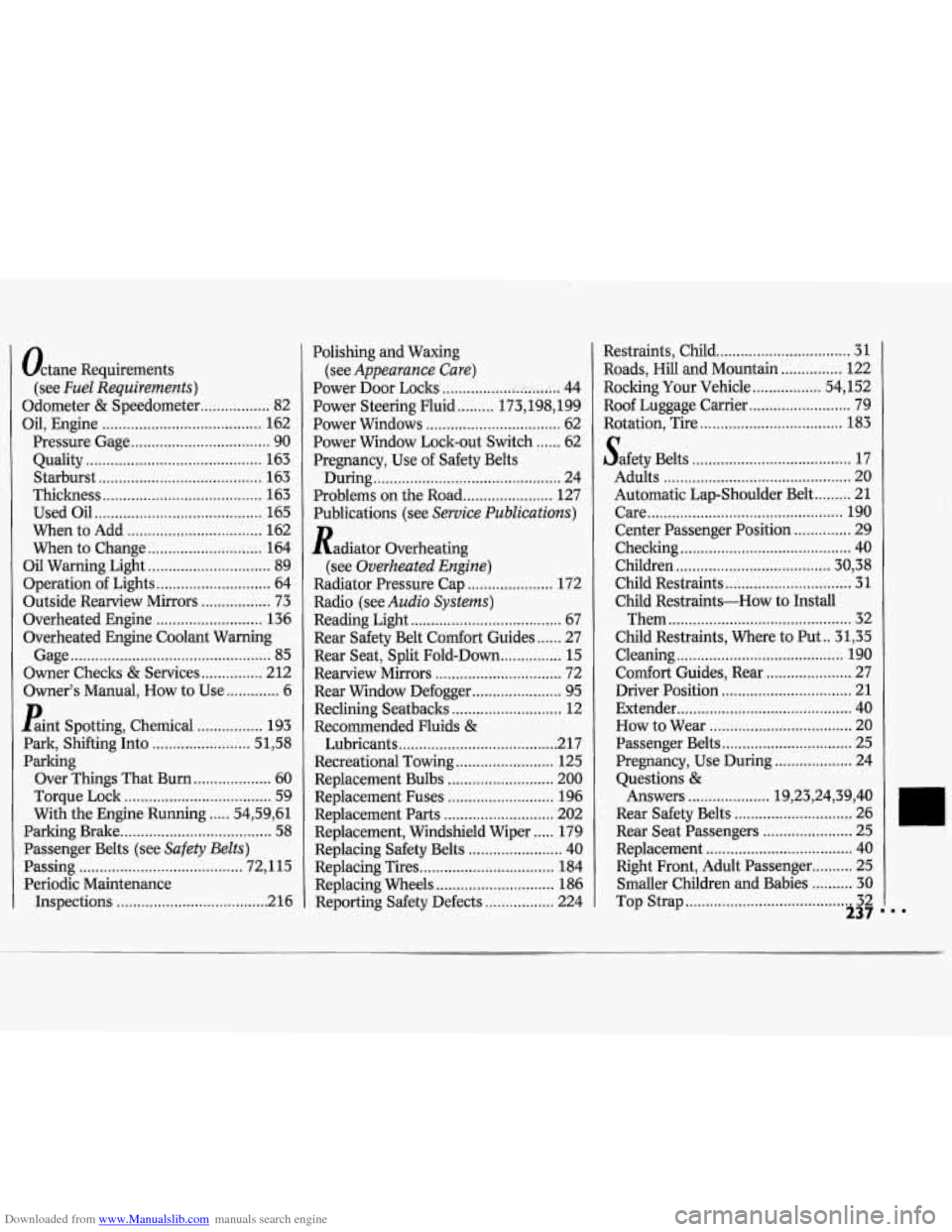
Downloaded from www.Manualslib.com manuals search engine Octane Requirements
Odometer
& Speedometer ................. 82
(see
Fuel
Requirements)
Oil. Engine ....................................... 162
Pressure Gage
.................................. 90
Quality
........................................... 163
Starburst
........................................ 163
Thickness
....................................... 163
Used Oil
......................................... 165
When
to Add ................................. 162
When to Change
............................ 164
Oil Warning Light
.............................. 89
Operation of Lights
............................ 64
Outside Rearview Mirrors
................. 73
Overheated Engine
.......................... 136
Overheated Engine Coolant Warning Gage
................................................. 85
Owner Checks & Services ............... 212
Owner’s Manual. How to Use
............. 6
paint Spotting. Chemical
................ 193
Park. Shifting Into
........................ 51. 58
Parking
Over Things That Burn
................... 60
With the Engine Running
..... 54.59. 61
Passing
........................................ 72. 115
Inspections
..................................... 2 16
Torque
Lock
.................................... 59
Parking Brake
..................................... 58
Passenger Belts (see Safety Belts)
Periodic Maintenance Polishing
and Waxing
Power Door Locks
................. i. ........ ;. 44
Power Steering Fluid
......... 173,198, 199
Power Windows
................................. 62
Power Window Lock-out Switch
...... 62
Pregnancy, Use of Safety Belts
During
.............................................. 24
Problems on the Road
...................... 127
Publications (see
Service Publications)
Radiator Overheating
(see
Overheated Engine)
Radiator Pressure Cap ..................... 172
Radio (see
Audio Systems)
Reading Light ..................................... 67
Rear Safety Belt Comfort Guides
...... 27
Rear Seat, Split Fold-Down
............... 15
Rearview Mirrors ............................... 72
(see
Appearance
Care)
Rear Window Defogger ...................... 95
Reclining Seatbacks
........................... 12
Recreational Towing
........................ 125
Recommended Fluids
&
Lubricants ....................................... 217
Replacement Bulbs
.......................... 200
Replacement Fuses
.......................... 196
Replacement Parts
........................... 202
Replacement, Windshield Wiper
..... 179
Replacing Safety Belts
....................... 40
Replacing Tires
................................. 184
Reporting Safety Defects
................. 224
Replacing Wheels
............................. 186
Restraints. Child ................................. 31
Roads. Hill and Mountain
............... 122
Rocking Your Vehicle
................. 54. 152
Rotation. Tire
................................... 183
Roof Luggage
Carrier
......................... 79
S afety Belts ....................................... 17
Adults .............................................. 20
Automatic Lap-Shoulder Belt
......... 21
Care
................................................ 190
Center Passenger Position
.............. 29
Checking
.......................................... 40
Children
...................................... 3 0, 38
Child Restraints
............................... 31
Child Restraints-How to Install
Them
............................................. 32
Child Restraints, Where to Put
.. 31, 35
Cleaning
......................................... 190
Comfort Guides, Rear
..................... 27
Driver Position
................................ 21
Extender
........................................... 40
How to Wear ................................... 20
Passenger Belts
................................ 25
Pregnancy, Use During
................... 24
Questions
&
Answers .................... 19,23,24,39, 40
Rear Safety Belts ............................. 26
Rear Seat Passengers
...................... 25
Right Front, Adult Passenger
.......... 25
Smaller Children and Babies
.......... 30
Replacement .................................... 40
Top Strap
......................................... 32
237